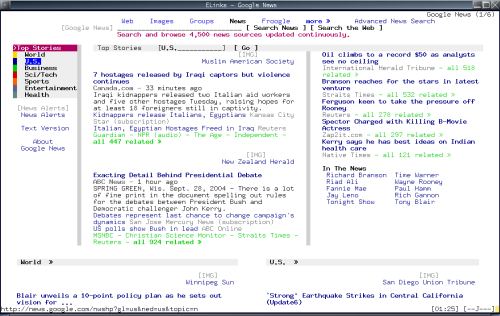
When I first fired up w3m, it reminded me of a cross between the classic text-based browser Lynx and the UNIX/Linux text viewer more. ELinks opens the image with an application like ImageMagick or GraphicsMagick. Either click the placeholder for the image or highlight it and press v on your keyboard. Press ESC on your keyboard display a set of menus that let you enter and save URLs, add bookmarks, set up the browser, and more.ĮLinks lacks a graphical mode, but it does have a nifty feature that lets you view images on a web page. One feature that makes ELinks stand out from other command line browsers is its menu system. While it supports using a mouse to follow hyperlinks, ELinks lacks support for Javascript. And like Links2, ELinks can display tables and frames. Like Links2, ELinks is a fork of the Links browser. You can also use your mouse to follow hyperlinks whether you're in text or graphical mode. The browser can display frames and tables, and supports basic JavaScript. That's not the only trick that Links2 can do. When you start it by typing links2 at the command line and go to a website, the result is something like this:īut when you run links2 -g then visit a site, the result is something like this: It's a lot like its predecessor in that it gives you the option to run either in text-only mode or graphical mode. Links2 bills itself as the graphical version of the venerable Links. Let's take a look at three browsers for the command line. They're niche, but still get the job done. Web browsers that run in a terminal window are alive and kicking. You'd think that browsing the web at the command line would have gone the way of the tag. Jump forward to these days of web browsers like Firefox, Chrome, Safari, and a few others. Some of use visited web pages using command-line, text-only browsers like the venerable Lynx. A time when most of us went online using low-powered PCs or dumb terminals, often over slow dial-up connections. Let's take a trip back in time to the early, simpler days of the web.

These latter features may be used to override decisions made by apt-get's conflict resolution system.( Note: This post was first published, in a slightly different form, at and appears here via a CC-BY-SA 4.0 license.)
#Elinks browser plus#
Similarly a plus sign can be used to designate a package to install.

If a hyphen is appended to the package name (with no intervening space), the identified package will be removed if it is installed. The /etc/apt/sources.list file is used to locate the desired packages. All packages required by the package(s) specified for installation will also be retrieved and installed. Each package is a package name, not a fully qualified filename.
#Elinks browser install#
APT simplifies the process of managing software on Unix-like computer systems by automating the retrieval, configuration and installation of software packages, either from precompiled files or by compiling source code.Īpt-get is the command-line tool for handling packages, and may be considered the user's "back-end" to other tools using the APT library.Īpt-get install is followed by one or more packages desired for installation or upgrading.
#Elinks browser free#
More information about install using apt-getĪdvanced Package Tool, or APT, is a free software user interface that works with core libraries to handle the installation and removal of software on Debian, Ubuntu and other Linux distributions.


 0 kommentar(er)
0 kommentar(er)
